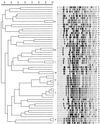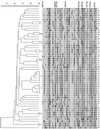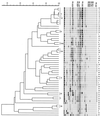Application of different genotyping methods for Pseudomonas aeruginosa in a setting of endemicity in an intensive care unit
- PMID: 10523569
- PMCID: PMC85717
- DOI: 10.1128/JCM.37.11.3654-3661.1999
Application of different genotyping methods for Pseudomonas aeruginosa in a setting of endemicity in an intensive care unit
Abstract
Colonization with Pseudomonas aeruginosa was studied by taking serial swab specimens from the oropharynges and anuses and tracheal and gastric aspirates from patients in an intensive care unit during a 10-month period in a setting of endemicity. Nineteen (10%) of the 192 patients included in the study were colonized on admission, while another 30 (16%) patients acquired P. aeruginosa while in the hospital. Typing of 353 isolates was performed by random amplified polymorphic DNA (RAPD) analysis, and 56 strains were selected for further typing by RAPD analysis, pulsed-field gel electrophoresis (PFGE), and amplified fragment length polymorphism (AFLP) analysis. By these methods, 42, 44, and 44 genotypes were found, respectively. Computer-aided cluster analysis indicated that similar groups of related isolates were obtained by each method. By taking admission periods into account, analysis of the typing results suggested cross-acquisition of P. aeruginosa for five patient pairs. The small number of transfers and the large number of genotypes found indicate that most P. aeruginosa strains were derived from the patients themselves. The numbers of observed typing patterns and band differences between related isolates were counted for each typing method. AFLP analysis with primers without a selective base proved to be the most discriminatory method, followed by PFGE, AFLP analysis (with one selective base), and RAPD analysis. On the basis of a comparison with established strain differentiation criteria for PFGE, the criteria for differentiation of P. aeruginosa by AFLP analysis are presented.
Figures




References
-
- Bonten, M. J., D. C. J. J. Bergmans, H. Speijer, and E. E. Stobberingh. Characteristics of polyclonal endemicity of Pseudomonas aeruginosa colonization in intensive care unit: implications for infection control. Am. J. Respir. Crit. Care Med., in press. - PubMed
-
- Grundmann H, Schneider C, Daschner F D. Fluorescence-based DNA fingerprinting elucidates nosocomial transmission of phenotypically variable Pseudomonas aeruginosa in intensive care units. Eur J Clin Microbiol Infect Dis. 1995;14:1057–1062. - PubMed
Publication types
MeSH terms
Substances
LinkOut - more resources
Full Text Sources
Other Literature Sources

